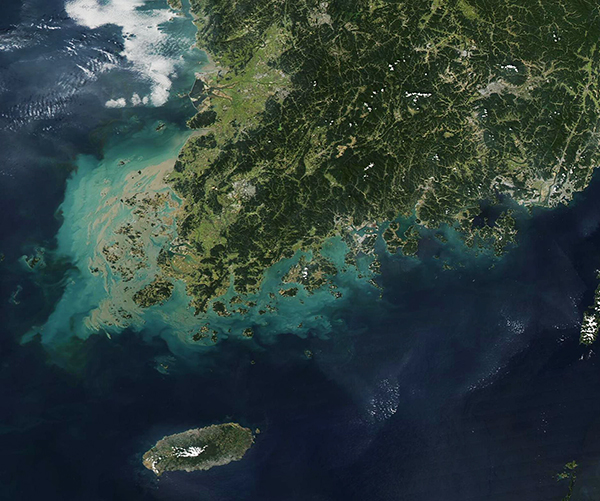Images
October 2, 2022 - Sediment off South Korea
Tweet
The waters surrounding the southern coast of South Korea were tinted with muddy-tan and tinged with green in late September 2022. The Moderate Resolution Imaging Spectroradiometer (MODIS) on board NASA’s Terra satellite acquire a true-color image of the scene on September 28.
The striking colors the result of sediment floating in the Yellow Sea (west) and Sea of Japan (east) off the coast of South Korea. More than 1,000 islands sit off the southwest coast of the country, and most are surrounded by shallow tidal flats. As tides wash across the flats, mud, sand, and other sediment is stirred up to float on the surface of the waters. The tidal flats, called "getbol" in Korean, are highly productive ecosystems. The mineral-rich sediments are full of microorganisms that attract marine animals such as clams and mud octopuses. The flats serve also as an important stopover for many migratory birds.
When sediment floats near the surface, it lends a tan or mud-colored tone to the water, as can be seen around the islands of Sinan County. However, as sediment sinks under the surface, the reflectivity changes, making it appear green and then blue as it sinks deeper under the surface. This transition can be seen most clearly around the islands, but also occurs off the southeastern coast of South Korea.
Image Facts
Satellite:
Aqua
Date Acquired: 9/30/2022
Resolutions:
1km (193.6 KB), 500m (507.2 KB), 250m (1.1 MB)
Bands Used: 1,4,3
Image Credit:
MODIS Land Rapid Response Team, NASA GSFC
Tweet
The waters surrounding the southern coast of South Korea were tinted with muddy-tan and tinged with green in late September 2022. The Moderate Resolution Imaging Spectroradiometer (MODIS) on board NASA’s Terra satellite acquire a true-color image of the scene on September 28.
The striking colors the result of sediment floating in the Yellow Sea (west) and Sea of Japan (east) off the coast of South Korea. More than 1,000 islands sit off the southwest coast of the country, and most are surrounded by shallow tidal flats. As tides wash across the flats, mud, sand, and other sediment is stirred up to float on the surface of the waters. The tidal flats, called "getbol" in Korean, are highly productive ecosystems. The mineral-rich sediments are full of microorganisms that attract marine animals such as clams and mud octopuses. The flats serve also as an important stopover for many migratory birds.
When sediment floats near the surface, it lends a tan or mud-colored tone to the water, as can be seen around the islands of Sinan County. However, as sediment sinks under the surface, the reflectivity changes, making it appear green and then blue as it sinks deeper under the surface. This transition can be seen most clearly around the islands, but also occurs off the southeastern coast of South Korea.
Image Facts
Satellite:
Aqua
Date Acquired: 9/30/2022
Resolutions:
1km (193.6 KB), 500m (507.2 KB), 250m (1.1 MB)
Bands Used: 1,4,3
Image Credit:
MODIS Land Rapid Response Team, NASA GSFC




